Excellence Mask. On the magic of "Merlin" put in a word
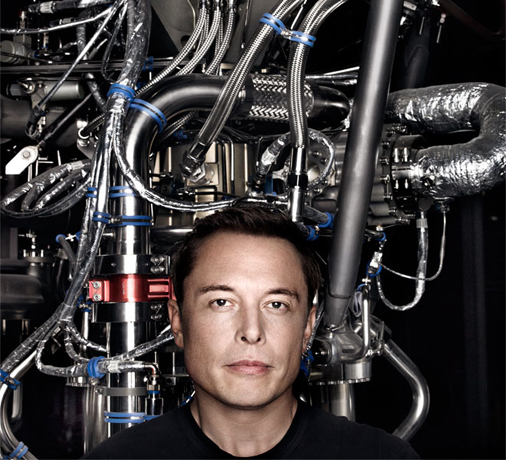
“There is no engine - and any most perfect rocket design with all its stuffing is dead” V.P. Glushko
In recent years, the private space company Space X, headed by Elon Musk, has not ceased to amaze the whole world with its fantastic successes. The main highlight of the space transport systems of this company are the Falcon launch vehicles, and in particular the Merlin 1 engines, already nicknamed the "most efficient in the world."
It seems false that Space X was able to create an engine in a relatively short time that overshadowed the development of giants such as Energomash and Rocketdyne in this area.". Under the cut, we will familiarize ourselves in a popular way with the modern world of rocket engines and try to understand their ambiguous characteristic as efficiency.
In 2012, Space X carried out fire tests of the latest modification of the Merlin 1 - D engine. During these tests, the engine's thrust ratio was brought to 150 units, which allowed Space X to be called "the most effective in history . "
In the field of engine building, thrust-to-weight ratio is the ratio of engine thrust (in tf) to its dry weight. In the case of rocket engines, this ratio is usually the thrust of the engines in vacuum (in tf) divided by its dry mass (in tons).
Merlin 1D is capable of developing traction near the ground in 67t and 82t in vacuum (Melin 1D Vacuum), with a mass of about 600kg. On Falcon 9 1.1, 9 such engines with a total thrust of 600 tf are used. The engine does not have its own thrust vector control system (UHT), and the rocket stage is controlled by changing the thrust of the engines on the opposite axes, as in the HN 1 (throttle to reduce thrust and / or afterburner to increase thrust above the nominal).
Merlin 1D engines on the Falcon 9 1.1
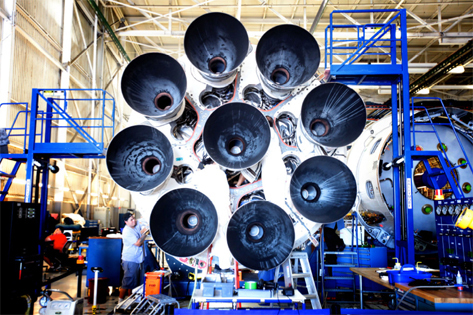
The difference between the thrust of engines near the earth and in a vacuum is typical, and is associated with a deterioration in engine performance in dense layers of the planet’s atmosphere. The resistance of the atmosphere to the aerodynamics of the engine increases in proportion to the size of the exhaust nozzle of the engine (the total resistance to atmospheric pressure only increases with increasing area of the jet exhaust). It would seem that it is only necessary to minimize the size of the nozzle and improve engine performance. However, with an increase in altitude, the atmospheric resistance decreases, and with it the engine characteristics, on the contrary, increase with an increase in nozzle size.
The key in this case is not the absolute size of the nozzle, but the degree of expansion — the ratio of the largest sectional area of the nozzle cone to its smallest sectional area. The higher this value, the higher the engine efficiency in a given environment. Therefore, the size of the nozzle of the vast majority of the engines of the first stage of launch vehicles is a compromise for the optimal characteristics of the engines, both in the atmosphere and in vacuum.
The thrust-weight ratio indirectly depends on the fuel used, and unlike such characteristics as thrust and specific impulse, it does not apply to all types of engines - solid-propellant rocket systems themselves are engines.
The highest thrust-to-weight ratio are the LRE working on a mixture of heptyl and diazot tetraoxide. So the engines of the RD 275M (Energomash) rocket of the Proton M carrier have the highest thrust-weight ratio in the world - more than 170 (thrust in the void 187t, engine weight 1.1t). Their "elder" brother RD 270 , which was being developed at one time for the unflown LV Ur 700, had a thrust-weight ratio of 200 units! It is even more surprising that we are talking about closed-cycle engines (see below). Such characteristics are achieved due to self-igniting fuel, due to which the design (and weight) of rocket engines is greatly simplified. At the same time, such engines have rather high specific impulse parameters (285 s for RD 275M).
RD 275M, the Russian modification of the base Soviet RD 253 engine for Proton launch vehicles (payload mass increased by 750 kg)
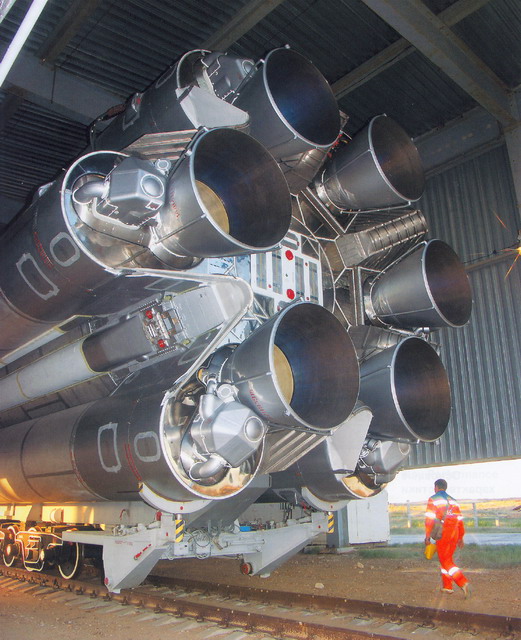
Specific impulse (sometimes referred to as specific thrust), expresses the time during which the engine develops thrust of 1 newton (1N = 1 kgf / 0.102) using 1kg of fuel. Higher higher the less fuel the engine needs to deliver a certain amount of movement to the payload. In contrast to the thrust-weight ratio, engineers often take this value as an indicator of engine efficiency.
Mr H
Modern hydrogen engines are the most efficient among all types of LREs used. The highest value possessed the Soviet RD 0120 (455s in vacuum and a thrust of 200 tons). The highest value at sea level, it possesses RS 68 (365s and a traction of 295tf) Rocketdyne company, used on the world's only fully hydrogen Delta 4. The hydrogen hydrogen rocket engine at the same time has the lowest thrust ratio (within 50-75 units), which is ignored due to high energy capabilities of these rocket engines. This allows you to more than compensate for the "extra" several tons of the engine, compared with other high-throttle rocket engines.
However, the high price of hydrogen liquid propellant rocket engines (about $ 20 million for RS 68) still forces engineers to use compromise options at the first stages, most often with kerosene liquid propellant rocket engines.
Visual table of the effect of the degree of expansion on the efficiency of cryogenic engines in different environments

From left to right: RS 68, Vulcain, RS 25, RD 0120

Champion in the narrow sense.
The highest specific impulse at sea level (311 sec) among kerosene rocket engines is possessed by RD 171, RD 180 engines (½ version of RD 171 cut with a thrust of 384 tf) and RD 191 (version of RD 171 cut by Д with a thrust of 196 t) of NPO Energomash ". The thrust-weight ratio of these engines does not exceed 90 units. Against the background of these masterpieces of technical thought, the effectiveness of the Merlin 1D looks rather modest (285 seconds), although it dominates the thrust-weight ratio among kerosene rocket engines.
RD 171/180/191

List of the most famous LPRE NPO Energomash.
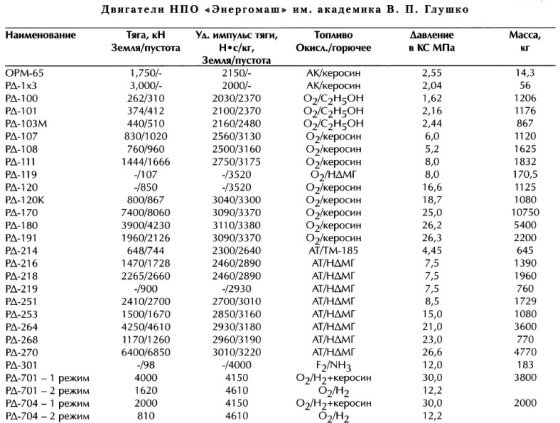
Such a difference in performance is associated with a different design approach when designing engines:
- LRE of the "family" RD 170/171 are made according to a closed-loop scheme - to initialize the engine, pressure is supplied to the gas generator, the gases from which drive a turbine that rotates the fuel and oxidizer pumps. Part of the incoming fuel goes to the cooling of the nozzle and then to the combustion chamber, the other part goes to maintaining the operation of the gas generator together with the oxidizer, and then after the turbine through the gas outlet, the mixture enters the combustion chamber. The entire closed cycle is repeated until the fuel in the tanks is exhausted. In this case, the combustion chamber of a closed-circuit rocket engine is substantially smaller than that of an open-cycle rocket engine. As you probably guessed, this provides high pressure in the combustion chamber (usually 200 atmospheres or more) and a large degree of expansion of the engine nozzle,
Disadvantages - high load on the turbine of the engine, relatively high complexity and cost of such engines.
An approximate closed-circuit liquid propellant rocket engine using the example of Russian RD 191 and NK 33 engines. 1 - Gas generator; 2 - Turbine; 3 - Fuel supply (kerosene); 4 - Supply of oxidizing agent (oxygen); 5 - fuel pump; 6 - oxidizer pump; 7 - The removal of part of the fuel to cool the nozzle; 8 - The removal of the gas mixture of the fuel / oxidizer from the turbine into the combustion chamber; 9 - Transfer of the oxidizing agent to the gas generator

- The liquid propellant rocket engine of the Merlin family and RD 107/108 (LV Soyuz) are typical representatives of open-cycle engines. The working fluid of the engine turbine (coming from the gas generator) does not close on the combustion chamber, but is discharged into the external environment along with part of the fuel, only partially participating in the creation of additional thrust. To compensate for efficiency losses, it is possible to increase the pressure in the gas generator, which increases the efficiency of the turbine and, accordingly, the pressure in the combustion chamber (which is about 100 atmospheres). Engines of such a scheme are simpler, more reliable, lighter and cheaper than a closed-circuit rocket engine.
Among the shortcomings, it should be noted the low degree of expansion of the engine nozzle and, accordingly, lower values of specific impulse when working in the atmosphere of the planet (263 / 257s for RD 107/108 and 255s for RS 27A).
The scheme of open-cycle engines on the example of liquid fuel engines F 1 and Merlin 1D. 1 - Fuel and oxidizer supply from tanks; 2 - gas generator; 3 - Oxidizer pump (oxygen); 4 - Fuel pump (kerosene); 5 - Turbine; 6 - Pipeline oxidizer high pressure; 7 - High pressure fuel pipeline; 8a - Fuel nozzle cooling system; 8b - Heat pipe of the gas of the gas generator; 9 - Exhaust gas mixture (Merlin 1D) / gas outlet gas to cool the nozzle nozzle (F 1); 10 - nozzle nozzles
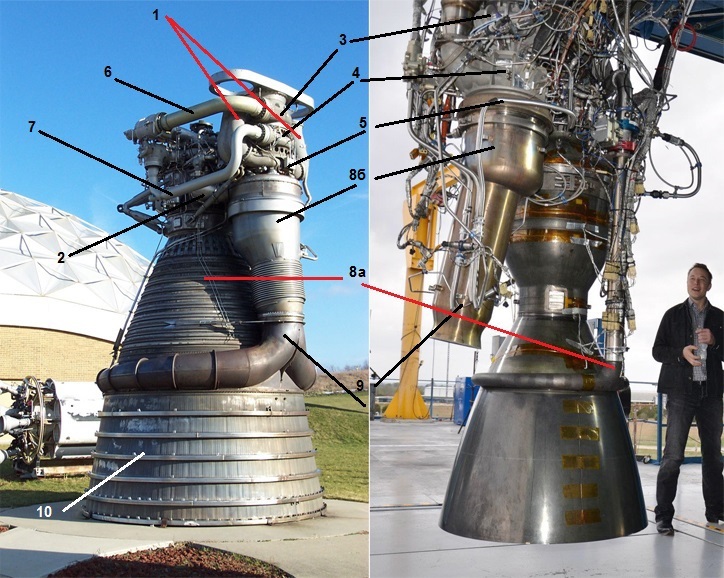
Comparing the engines of the first stage, it should be noted that the thrust-weight ratio of the engine is not directly related to the thrust-weight ratio of the entire stage. With equal thrust of rocket engines, not their comparative thrust-to-weight ratio, but specific impulse will be of decisive importance. As we said, the higher its value, the less fuel the liquid propellant rocket uses to disperse a certain mass and, therefore, the higher the thrust ratio of the launch vehicle stage.
So the thrust-to-weight ratio of the Falcon 9 1.1 LV is 1.2 (thrust of 600 tons / 503 tons of rocket mass), and the Zenith 2 with RD 171 1.5 (thrust of 720 tons / 470 tons of rocket weight) with a similar payload on the NOO of 13 tons.
To understand this approach of domestic designers, the geographical specifics of the location of Russian and American spaceports should be taken into account. The latter, located to the south, have a 15% energy advantage due to the greater contribution of the Earth's rotation (additional ~ 200 m / s). Therefore, high thrust-to-weight ratio is a common occurrence for domestic launch vehicles (1.5-1.7 for LV Energia and N1, versus 1.1 for Saturn 5). And as we already understood, the thrust-weight ratio of a rocket engine itself is not of key importance for this.
However, in the USSR, a kerosene engine was still created, combining high thrust-weight ratio and a large specific impulse. The NK 33 LRE from the Kuznetsov Design Bureau, based on the NK 15 engine of the N 1 lunar rocket, with a thrust ratio of 136 (171 tf / 1.25 t), had a specific impulse of 297 s (at sea level). A modern modification of the engine is used on the pH Anateres, a private company Orbital Sciences (AJ26). The Russian modification of the NK 33-1 used on the Soyuz 2.1v launch vehicle, at the start it develops traction already at 185tf with a specific impulse of 305s! From the basic version of NK 33, this engine differs, first of all, by the presence of a thrust vector control system (UHT).
In the future, on NK 33-1 it is planned to use nozzle nozzles extending at high altitudes, which noticeably improves the technical characteristics of the engine.
NK 33-1 with nozzle nozzle. On the right, a graph of the increase in the performance of a rocket engine with nozzle nozzle

Price issue.
Undoubtedly, one of the main "characteristics" of any type of equipment is its cost. Due to the large difference in the technical characteristics of the engines, it would be preferable to compare their relative price values. In this case, this value is approximately the ratio of the price of the rocket engine to its thrust ($ / tf).
Poster "Energomash", showing the pricing scheme of the liquid propellant rocket engine and their share in the price of the entire launch vehicle. Obviously, the price increases in proportion to the complexity of the engine and its efficiency. So the RS 68s on Delta 4 launch vehicles cost NASA $ 60,000 / tonne of thrust ($ 20 million). A kerosene liquid propellant rocket engine with higher thrust but lower specific impulse RD 180 (RN Atlas 5) nominally costs NASA half the price - $ 30,000 / tf ($ 11 million).
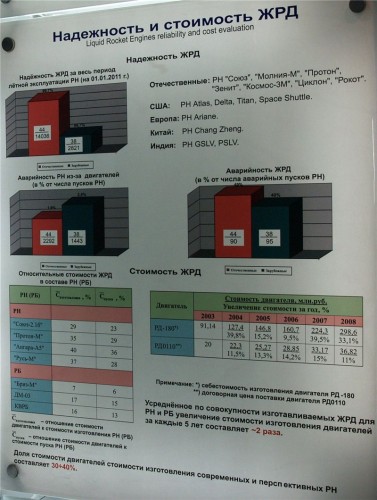
RD 191, which is in service with the Angara LV, is considered in relative prices to be one of the most expensive kerosene rocket engines in the world - $ 36,000 / tf (250 million rubles).
For comparison, the price of RD 171, on the basis of which the RD 180/191 was created, is in the range of $ 22,000 / tf ($ 13-15 million). This scatter is partly due to the fact that the last two engines were created for the US domestic market, in particular for the Atlas 5 launch vehicle (RD 180 as the main engine of the central unit, and RD 191 as the engine for side units). However, RD 191 remained unclaimed in the United States, even after the creation of a more budgetary RD 193 (version without UVT).
The most “cheap” closed-cycle engine can be considered the NK 33-1 LRE. Given the restoration of production, the price of the modification of NK 33-1 for the new Soyuz 2-3 launch vehicle can be up to $ 25,000 / tf ($ 4.5 million). Officially, NK 33-1 will be used until the old NK 33 reserves are depleted and replaced by RD 193 engines .
Merlin 1D with an approximate price of $ 15,000 / tf (~ $ 1 million), very successfully "joined" in the domestic market of rocket engines in the United States. After the Apollo program closed, the United States for half a century focused on the development of cryogenic (hydrogen), toxic (heptyl) and solid fuel rocket systems. The consequences of this approach are observed today - ahead of Russia in terms of the development and operation of cryogenic rocket engines and turbojet engines, the United States is far behind in terms of the development of already kerosene rocket engines.
Even if they develop their own kerosene liquid propellant rocket engines in the USA, it is highly doubtful that they will be able to compete in terms of perfection and price with Russian engines and especially with the “budget” brainchildren of Space X. Therefore, Elon Mask and Co. have every reason to be optimistic about their future developments. Developments of extremely successful, reliable and promising, to which it is not at all necessary to “try on” controversial epithets long deserved by other talented developers .
I advise you to read:
RD 170/171 , RD 180 , RD 191 , NK 33 , NK 33-1 , RD 253/275 , RD 107/108
PROSPECTS FOR CREATING POWERFUL LIQUID ROCKET ENGINES
Perspective methane projects of Russia.
Another interesting topic on the Habr:
Special rocket magic. Ilona Mask.
Imperceptible difficulties of rocket technology. Part 3: types of liquid fuel, geometric dimensions, transportation.
Imperceptible difficulties of rocket technology: Part 4. More about engines and tanks of
PS: If you find errors or inaccuracies, do not forget to knock on the PM.
